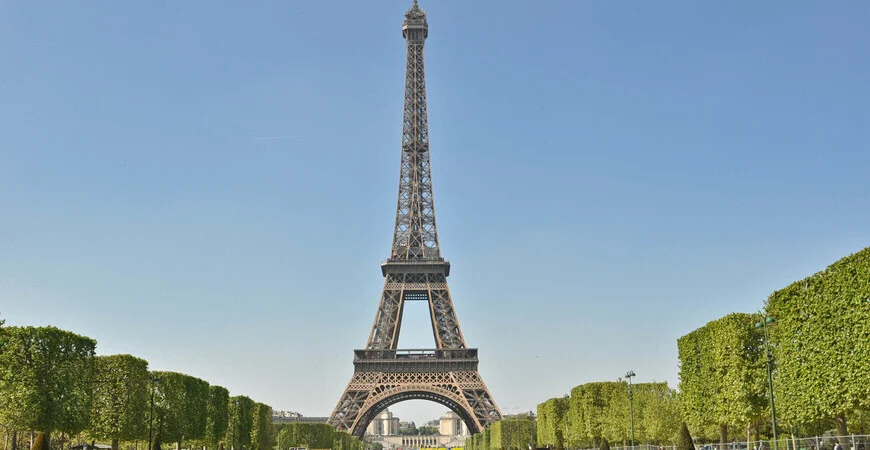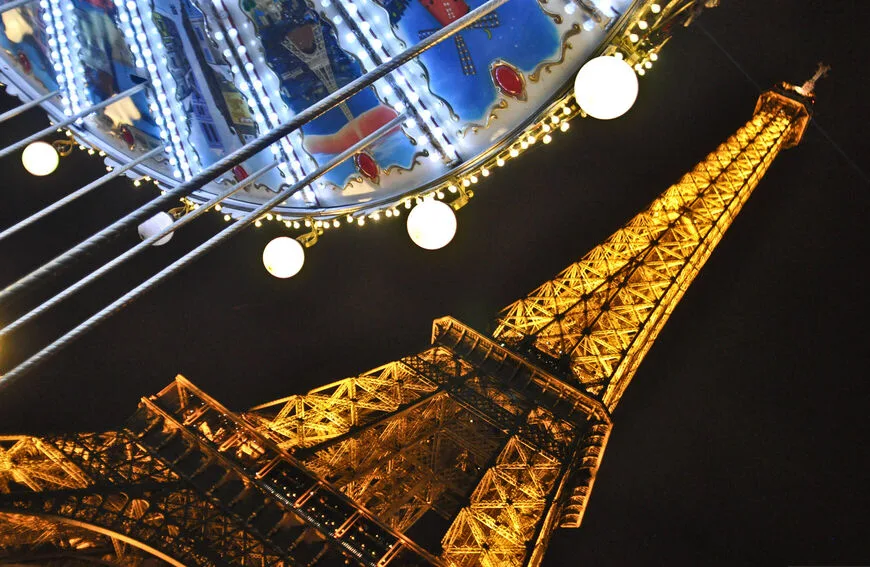The Eiffel Tower (Tour Eiffel) is one of the most famous landmarks in the world. She is called the object of contention, desire and charm. The Eiffel Tower is especially popular among lovers. Many consider it to be one of the most romantic things to do - to propose at the top of the tower. Although the Eiffel Tower was erected as a symbol of industrialization and aspiration for the future.
Tour Eiffel is recognized as a true architectural masterpiece. Many similar structures have been created around the world. The replica of the Eiffel Tower in Las Vegas is the tallest such replica. Moreover, the Eiffel Tower is the most recognizable landmark of the French capital. She has inspired artists, musicians, writers, filmmakers, photographers and other creators on many occasions. Famous artists using the image of the Eiffel Tower in their drawings include Seurat, Signac, Chagall, Delaunay; among the writers who mentioned her in their works are Apollinaire, Cocteau, Maupassant. And in modern creativity this image does not cease to be relevant: in 2017, the single "Voyage" by the "Leningrad" group was released. The chorus begins with the words: "Against the backdrop of the Eiffel Tower."
Tourists tend to take not only a photo of the Eiffel Tower, but also climb it to capture the panorama of the city. From the observation platforms, you can enjoy beautiful views and see other sights of the city. Unfortunately, due to its height, the Eiffel Tower is quite a frequent destination for suicides. However, not all attempts are successful.
A visit to the Eiffel Tower is a must-see for travelers in Paris. You can see this building at any time of the year. During the day, the Eiffel Tower is accessible for climbing upward, and late at night it can be viewed from the side - this is an equally impressive view.
The French themselves call the building the "iron lady" ("La Dame de Fer"). This name of the Eiffel Tower is due to the material of which it is composed - metal.
 |
| Eiffel Tower |
Dimensions
The height of the Eiffel Tower is 324 m. This is the data for today, but the original height of the Eiffel Tower in Paris was 312 m. The current figure has increased due to the new antenna. It is interesting that the creator of the structure called it simply "300-meter tower". At the time of construction, the steel Eiffel Tower in Paris exceeded all structures in the world in height. To give an approximate idea of its size, the height is usually compared to an 81-storey building.
What's higher than the Eiffel Tower?
The Parisian structure remained the tallest in the world until 1930, when the Chrysler Building appeared in New York. To date, even more towers have been built that surpass Tour Eiffel Paris in height: for example, the famous Burj Khalifa in the United Arab Emirates, and in Russia - the Ostankino Tower.
The mass of the Eiffel Tower is 10,100 tons, the metal frame weighs 7,300 tons. Considering how huge this structure is, the weight of the Eiffel Tower is considered not very large. The number of different iron parts is 18,038 pieces. The dimensions of the Eiffel Tower are taken into account in the design features, therefore, the vibrations of the structure during hurricanes and winds reach no more than 15 cm.
The area of the Eiffel Tower, or rather the space on which it rests on the ground, is 500 square meters (one side between the columns is 125 m).
How much to climb the Eiffel Tower?
The ascent to the 1st and 2nd levels will take about 15 minutes on foot. There is only an elevator going to the top, the trip takes several minutes.
 |
| Eiffel Tower |
Eiffel Tower Tickets
Tickets are offered with the ability to climb to different levels. The price depends on this, as well as on how you climb the Eiffel Tower. The cost is also formed taking into account the age of the visitors:
- ticket to the Eiffel Tower in Paris with access to stairs up to the second level: € 10.50 for adults; 5.20 € for young people 12-24 years old; 2.60 € for children 4-11 years old and disabled;
- lift ticket up to level 2: € 16.70 for adults; 8.40 € for young people 12-24 years old; 4.20 € for children 4-11 years old and disabled;
- ticket with a staircase to the 2nd level and a lift to the top: € 19.90 for adults; € 9.90 for young people 12-24 years old; 5 € for children 4-11 years old and disabled;
- ticket with lifts to level 2 and to the top: 26.10 € for adults; € 13.10 for young people 12-24 years old; 6.60 € for children 4-11 years old and disabled;
- children under 4 years old are admitted free.
Prices for the Eiffel Tower go up every year. You can buy tickets for the Eiffel Tower online or locally. It should be borne in mind that tickets with the rise on the stairs to the 2nd level and further on the elevator to the top can be purchased only at the ticket offices near the tower. In other cases, tourists recommend buying tickets for the Eiffel Tower online.
Queuing up to the Eiffel Tower is common, so many people prefer to shop online. Tickets for the Eiffel Tower on the website are available approximately 2 months in advance in case of taking an elevator or 7 days in advance in case of going up stairs. In July-August and on weekends, there are always a lot of visitors, so tickets for the required date must be viewed in advance. In the calendar on the site, the days for which the last places on sale are left are highlighted in orange.
 |
| Eiffel Tower |
History
The history of the Eiffel Tower began with the 1889 World's Fair. It was held in the capital of France and was dedicated to the 100th anniversary of the Bastille. A few years before the exhibition, an architectural competition was announced in the country for a project demonstrating high technological capabilities.
Why the Eiffel Tower?
The building is named after its creator - Gustave Eiffel.
The company of the engineer Gustave Eiffel presented a project of a high iron tower for the competition. In fact, the designer at the Eiffel Tower is not alone, these are: the Eiffel himself, the engineers of his company Maurice Köchlen (Köschlen) and Emile Nugier, as well as the specially hired architect Stefan Sauvestre.
The Sauvestre was brought in to make the tower's appearance more aesthetic and attractive. He proposed pedestals at the base and arches connecting the columns to the first level. Halls with glass walls at different levels were also his idea.
What year is the Eiffel Tower?
It dates from 1889, but Nugier and Koehlen developed the first project back in 1884, they wanted to create a very high tower of metal beams on 4 columns. By the time of preparation for the World Exhibition, the idea had been finalized.
The Eiffel Tower from 1889 was a very daring and innovative proposal. In 1884, G. Eiffel registered a patent for a new configuration, allowing the construction of metal supports and pylons at a height of more than 300 m. When creating the Eiffel Tower, special attention was paid to details and technologies that create wind resistance.
The construction of the Eiffel Tower was proceeding at a very fast pace and on a strict schedule. The structural elements were manufactured at the Eiffel factory in Levallois-Perret. Every detail is designed and calculated with an accuracy of one tenth of a millimeter. The workers connected these parts with rivets.
 |
| Eiffel Tower |
The Eiffel Tower was built by 1889 in 2 years, 2 months and 5 days.
A concrete foundation was set several meters underground on top of the gravel. It took 5 months to build the foundation. The metal parts were assembled in 21 months. The Eiffel Tower celebrates its birthday on March 31, when all the work was completed.
For that time, the construction of the Eiffel Tower was completed in record time. Plus, it was built with incredible precision in every detail. At the same time, they did not express themselves in the most flattering words about the Eiffel Tower. In 1887, many artists expressed their "artists' protest" against this building. For example, among the dissatisfied were: Guy de Maupassant, Alexandre Dumas Jr., Charles Garnier and others. They did not like the artistic component of the design, which violates the beauty of Paris. The tower was called a bell tower, a street lamp, a tangled and deformed mast, a skinny pyramid of iron stairs, a clumsy skeleton, etc. Therefore, it should not be surprising why the Eiffel Tower was called ugly. Nevertheless, in defense of the design, it was said that it is art in the age of science and technology. With time,
The Eiffel Tower project became famous on the positive side - during the construction there was not a single death of workers. Safety in the rather difficult conditions of work at high altitudes was of the utmost importance. The only death had nothing to do with the production process.
